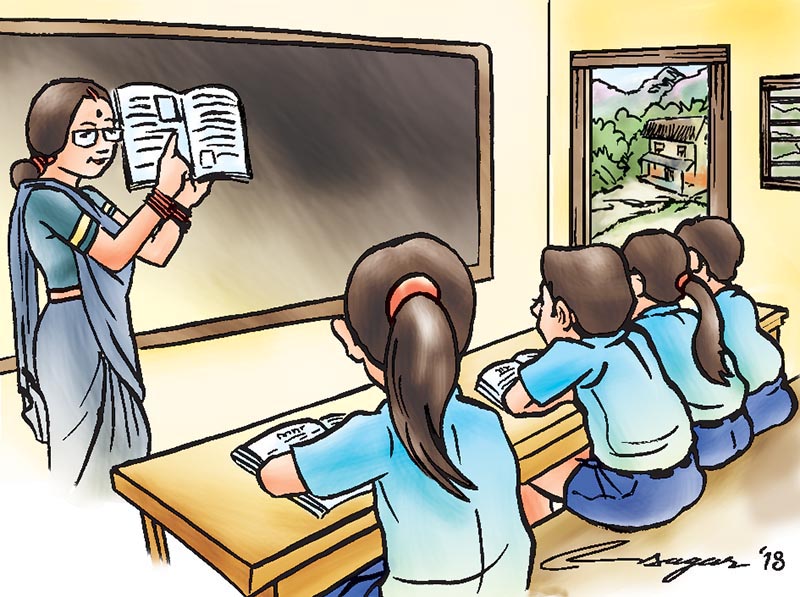Textbooks for all: Students must get them on time
Unavailability of textbooks, especially in rural schools, has made students rely on teachers’ notes, as they are the only source materials. In such a situation, students from poor economic background are likely to fall behind
The term “textbook” has been used in different contexts to refer to different concepts. Some use it to refer to any book used during education, but most limit it to books written specifically for classroom use. The textbook, in fact, is the heart of the school and teaching-learning activities and without the ubiquitous text, there would be no schools. Effective use of textbook helps in bringing and achieving the learning outcomes.
Textbooks carry a wide range of new and interesting facts and open the door to a world of a whole new experience. Teachers can play an important and crucial role in nurturing and supporting each child’s creative potential by the proper use of textbooks. Textbooks also help teachers to become more inspirational and motivational.
The National Curriculum Framework (NCF) has laid emphasis on the development of student-centred textbooks to systematise school education. Textbooks provide an outline of topics to work with for both the students and the teachers.
The education system in Nepal prescribes two levels of school education — basic school education (grades 1 to 8) and secondary school education (grades 9 to 12). In Nepal, the Curriculum Development Centre (CDC) is the apex body that develops the school curricula and other curricular materials.
Teachers in rural Nepal hugely rely on textbooks due to non-availability of other instructional materials. It takes the central and pivotal role in the context where teachers are not well qualified and students come from low-income background and do not have easy access to any other resources.
Textbooks are dependable and a critical part of education, as necessary as classroom itself and as indispensable as the classroom teacher since they are based on developed theory, authored by specialists and refined through active research. They not only provide structure to lessons and students’ progression but also encourage clarity regarding key concepts and core knowledge.
The curricula and textbooks should be more meaningful and relevant for life experiences of students so as to prepare them for real life challenges.
Though there are other teaching-learning resources, say training, and use of chart among others, the importance of the textbook use cannot be denied as they work as “bridges between the worlds of plans and intentions, and of classroom activities shaped in part by those plans and intentions”. Further, textbooks determine the range of possible activities for the classroom, thus influencing greatly what teachers are likely to do, even if they do not restrict what teachers can do.
From teachers’ perspective, textbooks provide extra resources such as chapter tests, worksheets of extra problems and project support materials. Furthermore, a teacher’s edition of the text can also remind teachers of alternative approaches to a topic so that s/she can provide guidance on sequence and timing. This also makes it easier to coordinate among teachers.
From parents’ perspective, textbooks show them what their children are learning and will learn. If a child has questions which parents cannot readily answer, they can refer to textbooks to help figure out the answer.
From students’ perspective, textbooks give them chapter review problems and sample tests and answers to the problems. They also usually have everything they need to know — highlighted in boxes or bold print.
It is quite obvious that teachers would be able to make effective use of textbooks only if they realise the value of textbooks as an important teaching and learning resources. Teachers are always at the forefront when it comes to implementation of the contents designed by the CDC and educational reform process.
The quality of education system entirely depends on the quality interaction between teachers and students through the use of textbooks in the classroom. Textbooks reflect the aims and objectives of the national curriculum. Therefore, the availability and the use of textbooks in the teaching learning process are very important.
Unavailability of textbooks, especially in rural schools, has made students rely on teachers’ notes, as they are the only source materials. In such a situation, students from poor economic background are likely to fall behind. Unavailability of textbooks and lack of creative skills ultimately lead to poor learning, which has greatly affected the quality of education of community schools. Practical subjects like science need textbooks that not only give instructions but also explain the procedures for experiments.
But the availability of textbooks only does not solve the problem. Their effective use is a must to build students’ confidence.
Shortages of textbooks or delays in distributing them to schools and children hugely affect teaching-learning activities.
Until and unless the government and concerned stakeholders understand the gravity of lack or shortage of textbooks and its trickle-down effect, education quality of community schools cannot be improved, which will mean making children deprived of their right to education. All concerned authorities must work to make quality textbooks available on time so as to enhance the quality of education as a whole.
Joshi is a faculty member at Patan Multiple Campus






